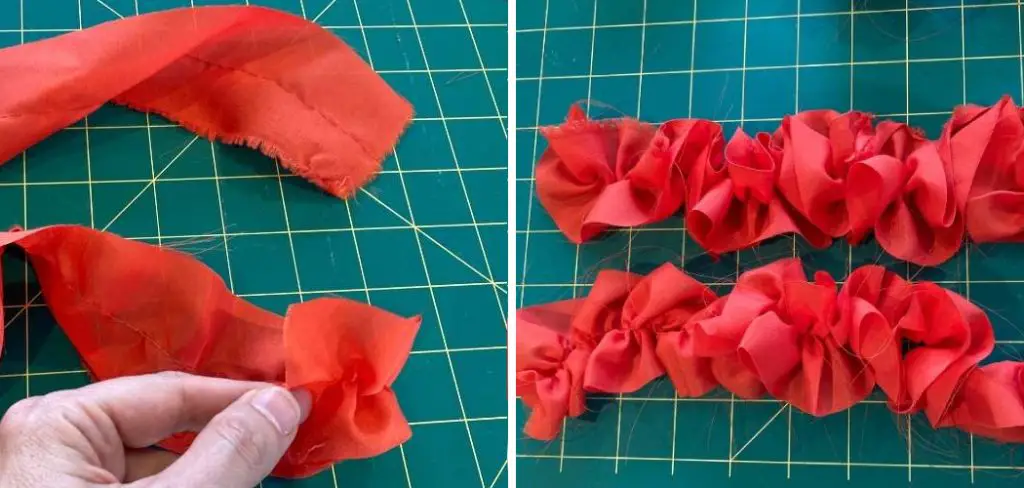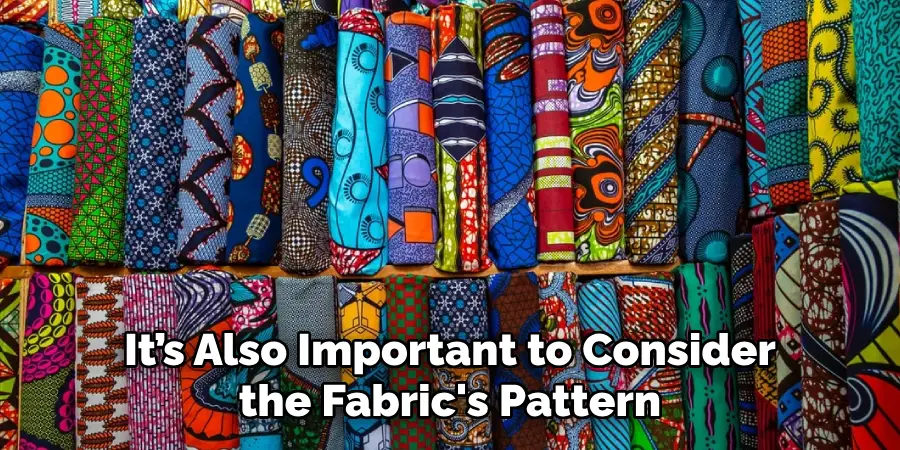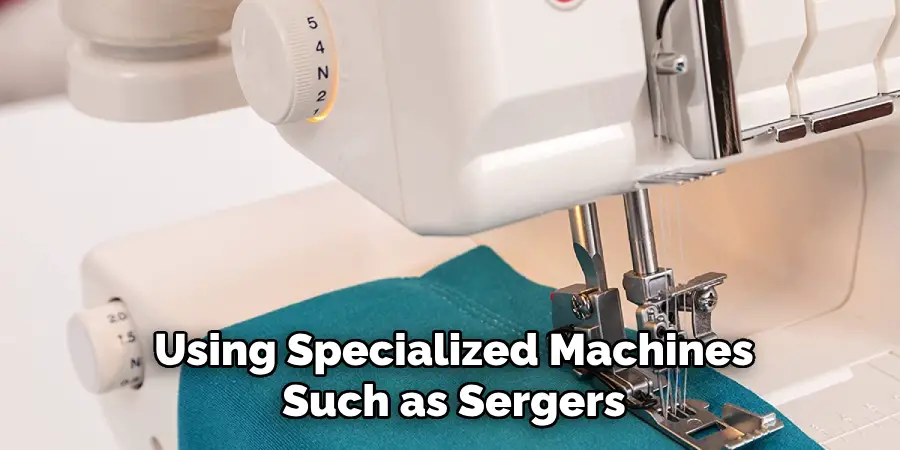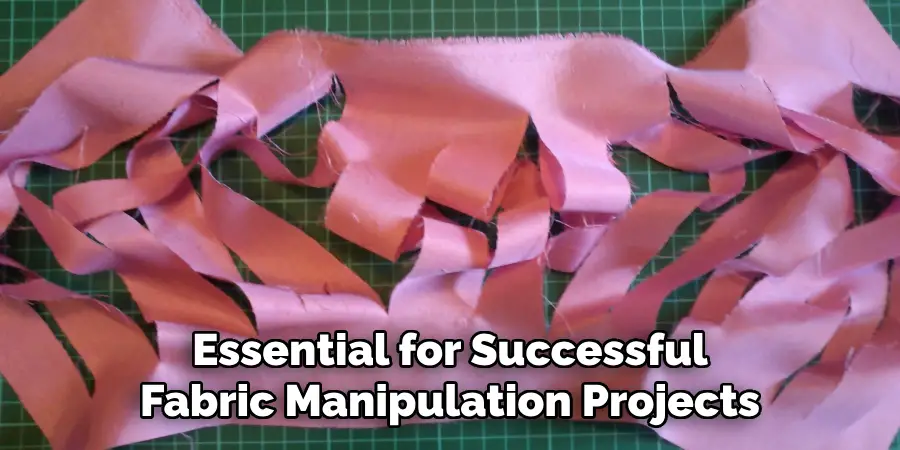Fabric manipulation transforms fabric into a textured, 3D piece of art using various techniques. Whether you want to create a unique dress, a decorative wall hanging, or an art quilt, fabric manipulation can add depth and dimension to any project.

If you’re intimidated by manipulating fabric, don’t worry – with the right tools and techniques, you can easily become a master fabric manipulator! In this blog post, we’ll guide you through the process of how to do fabric manipulation so you can start creating textured masterpieces in no time.
Can You Do Fabric Manipulation?
As the crafting and sewing world continues to evolve, so do the techniques used to create unique and stunning pieces. Fabric manipulation is one such technique that has gained popularity in recent years. It involves altering the fabric’s texture, shape, or appearance by folding, pleating, twisting, or even cutting it.
Whether it’s creating 3D flowers on a dress or adding intricate details to a quilt, fabric manipulation allows for endless possibilities for creativity and expression. If you love to experiment with different techniques and push your creative boundaries, then fabric manipulation is definitely worth exploring. You’ll be surprised at the beautiful and unique pieces you can create with a little patience and practice.
Why Should You Do Fabric Manipulation?
If you’re someone who loves to challenge themselves creatively, fabric manipulation is an artisanal craft that is worth exploring. This technique involves twisting, pleating, gathering, or layering fabrics to create new textures, shapes, and designs.

Not only does this add a unique touch to your creations, but it also showcases your skills as a designer. Fabric manipulation can be employed in various designs, from fashion to home decor, and it is a great way to experiment with color, patterns, and different fabrics.
This process may seem intimidating initially, but with practice, you can master the art of manipulating fabric to bring your creative vision to life. Whether you’re a seasoned designer or a beginner, fabric manipulation is an exciting and rewarding technique that can add a new dimension to your designs.
How to Do Fabric Manipulation: A Step-By-Step Guide
Step 1: Gather Your Materials
Before diving straight into fabric manipulation, you must gather several basic tools and materials, including a sewing machine, fabric scraps, scissors, pins, and a ruler. You can also use various yarns, threads, and ribbons to add more texture, and fabric glue or fusible interfacing can help to keep your fabric in place while sewing.
Step 2: Choose Your Technique
There are countless techniques for fabric manipulation, including pleating, smocking, shirring, ruching, tucking, and quilting. Each technique produces a unique look and texture, so explore different options and experiment to see what you like best.
Step 3: Practice Your Technique
Once you’ve settled on a technique, practice on a fabric scrap to get comfortable with the process. Take your time and be patient – fabric manipulation can be time-consuming, but the results are well worth it. Use your ruler and pins to ensure your lines and folds are straight and even.
Step 4: Plan Your Design
Before diving into your final project, plan out your design. Determine the placement and size of your folds and tucks, and consider the overall shape and design you want. You can sketch out your design on paper or use a dress form to visualize your project in 3D. This step will help ensure your final product turns out just how you imagined.
Step 5: Cut and Prepare Your Fabric
Now, it’s time to cut your fabric. Make sure to follow your design plan and add in any seams or darts as needed for structure. If using delicate fabrics, such as silk or lace, consider stabilizing them with interfacing before cutting to make the manipulation process easier.

Step 6: Manipulate Your Fabric
The fun part! Use your chosen technique to manipulate your fabric. Whether pleating, smocking, or shirring, take your time and pay attention to detail. This is where you can really let your creativity shine and play with different textures, dimensions, and patterns.
Step 7: Finishing Touches
Once you’ve completed your fabric manipulation, add any finishing touches, such as stitching or embellishments. You can add other fabrics or materials for a mixed-media effect. Don’t be afraid to experiment and try new techniques – fabric manipulation is all about adding unique elements to your designs.
That’s it! You’ve now learned how to do fabric manipulation in just seven simple steps. Remember to be patient and have fun with the process. With practice, you can create stunning, unique designs that will turn heads.
5 Considerations Things When You Need to Do Fabric Manipulation
1. Type of Fabric
The type of fabric you are working with is an important consideration for fabric manipulation. Different fabrics require different techniques and tools, so it’s important to familiarize yourself with the characteristics of the fabric you’re working with before beginning any project. Additionally, some fabrics may be more difficult to manipulate than others, so it’s important to choose a suitable fabric for your project.
2. Pattern
When manipulating fabric, it’s also important to consider the fabric’s pattern. If you are using a printed patterned fabric, make sure that you take into account how the design will look once manipulated and cut. Additionally, if you are creating a pattern from scratch, make sure that you plan out your design in advance so that you can accurately measure and cut the pieces needed for your project.

3. Tools
The tools used for fabric manipulation are just as important as the fabric type and pattern used. Ensure you have all of the necessary tools on hand before beginning any project; this includes scissors, pins, needles, thread, measuring tape, and any other materials or equipment needed for your project.
4. Timeframe
Time is another factor to consider when doing fabric manipulation work. Depending on your skill level and experience with a particular technique or tool set, some projects may take longer than others; therefore, it’s important to plan accordingly and give yourself plenty of time to complete each step to ensure success with your finished product.
5. Sewing Machine
If you plan on using a sewing machine for any part of your project, then make sure that you have one available beforehand; this will save time in the long run by allowing you to complete tasks faster than if done by hand alone.
Additionally, some machines may be better suited for certain projects than others, so make sure that you research which machine would be best for your specific needs before making a purchase or renting one from a store or online retailer.
5 Benefits of Fabric Manipulation
1. Increased Design Possibilities
Fabric manipulation can open up a world of design possibilities. You can create new textures, shapes, and patterns that are impossible with standard sewing techniques by manipulating fabric. Fabric manipulation also allows you to create pieces with a unique look and feel that can’t be replicated with other methods.
2. Improved Durability
Fabric manipulation techniques can also improve the durability of garments and accessories. You can reinforce seams and add extra strength to fabrics using specialized techniques such as zigzag stitching, topstitching, and buttonholing. This helps to ensure that your pieces will last for years to come.
3. Faster Production Times

Using fabric manipulation techniques can also help to speed up production times. By using specialized machines such as sergers or overlockers, you can quickly stitch together multiple layers of fabric without using traditional hand-sewing techniques. This helps to save time and money in the long run by speeding up production times and reducing labor costs.
4. Cost Savings
In addition to saving time, fabric manipulation techniques can also help you save money on materials and labor costs. For example, using stretchy fabrics such as spandex or lycra allows you to create garments that fit more closely without needing extra material for seams or darts. This helps reduce material costs while still creating a finished product that looks great on the wearer.
5. Improved Comfort
Finally, fabric manipulation techniques can help improve the comfort of garments by allowing them to move more freely with the body’s natural movements. For example, using elastic thread in hems or waistbands helps keep pants from sagging or riding up when worn for long periods, making them much more comfortable for the wearer.
6 Common Mistakes People Make When Trying to Do Fabric Manipulation
1. Not Understanding the Different Types of Fabric Manipulation
Fabric manipulation is a sewing technique that involves altering fabric to create a desired effect. Many types of fabric manipulation exist, such as pleating, gathering, smocking, and quilting. Understanding the different techniques before attempting any fabric manipulation project is important.
2. Not Pre-washing Fabric
Pre-washing fabric is an important step in any fabric manipulation project. Pre-washing helps to remove any dirt or debris from the fabric and also allows it to shrink before you start manipulating it. If you don’t pre-wash your fabric, you may end up with a finished product that doesn’t fit properly or looks wrinkled and uneven.
3. Not Testing Out Techniques Before Starting a Project
Before starting any fabric manipulation project, it is important to test out the techniques on scrap fabric first. This will help you become familiar with the process and ensure that your finished product looks exactly how you want it to look. It can also save time and money if something goes wrong during the process since you won’t have to start over with new materials.
4. Not Choosing the Right Needle Size for Your Fabric Type
Choosing the right needle size for your particular type of fabric is essential for successful fabric manipulation projects. Different fabrics require different needle sizes for them to be manipulated properly without causing damage or fraying of the fibers. Using too large of a needle size can cause holes in your fabrics while too small can cause skipped stitches and uneven results.

5. Not Using Proper Stitching Techniques
Proper stitching techniques when manipulating fabrics are key to achieving professional project results. Make sure that all of your stitches are even and consistent so that they blend together seamlessly when manipulated into their desired shapes or patterns.
Also, be sure to backstitch at each end so that all of your stitches are secure and won’t come undone over time or with wear and tear from use or washing cycles.
6. Not Sealing Your Finished Product
Once you have completed your fabric manipulation project, make sure that you seal it properly so that it lasts longer and maintains its shape over time. This can be done by using special products such as fray check or liquid stitch, which will help keep all of your stitches secured in place without damaging the fabric’s fibers.
Conclusion
Fabric manipulation is a beautiful and rewarding technique that can truly elevate your sewing projects to the next level. Whether you’re new to the craft or a seasoned pro, with a little practice and patience, you can become a fabric manipulation master in no time. So pick up some fabric scraps and start experimenting – endless possibilities! Thanks for reading our post about how to do fabric manipulation.

